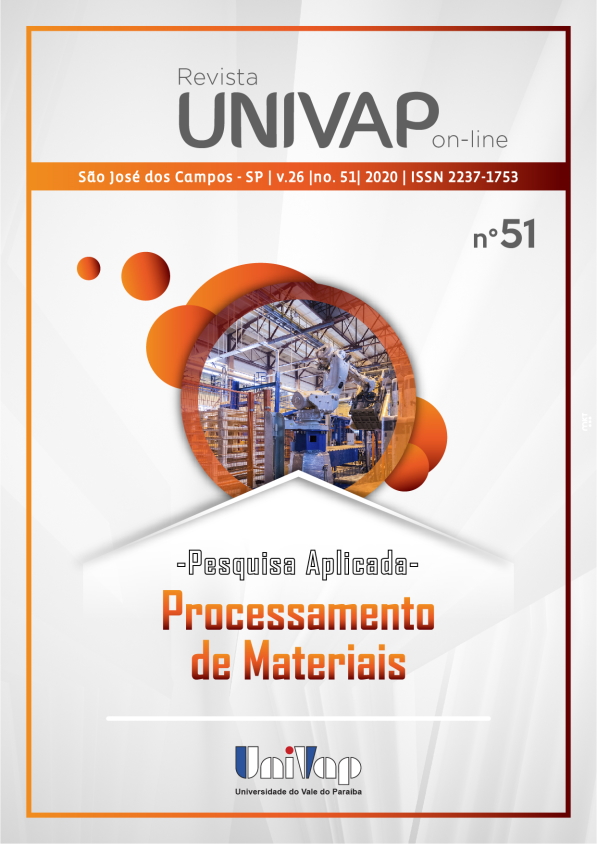APLICAÇÃO DE ESPECTROSCOPIA NO INFRAVERMELHO: COMO FERRAMENTA PARA ANÁLISE QUANTITATIVA DE ORÉGANO
DOI:
https://doi.org/10.18066/revistaunivap.v26i51.2451Palavras-chave:
Espectroscopia no infravermelho, FTIR, orégano, análise multivariada.Resumo
Desde a antiguidade as ervas aromáticas são utilizadas, não somente para melhorar o sabor e odor em alimentos, mas também para estender o tempo de prateleira com suas propriedades antissépticas. O aumento da utilização das ervas aromáticas na culinária tem sido aprimorado praticamente no mundo todo e principalmente na gastronomia. Entre as ervas mais consumidas no Brasil, o orégano (Origanum vulgare) tem origem mediterrânea e trata-se de uma erva muito aromática, com notas de cânfora, sabor ardido e picante. O presente estudo tem como objetivo analisar quantitativamente e qualitativamente a composição biomolecular das amostras de orégano utilizando técnicas espectroscópicas no infravermelho com transformada de Fourier (FT-IR). Com os resultados, foi possível notar diferenciação na quantidade de lignina, água e lipídio, e a análise multivariada permitiu identificar a similaridade das amostras analisadas. O uso de espectroscopia no infravermelho tem se mostrado uma ótima ferramenta na análise de alimentos, podendo ser aplicada em conjunto com outras técnicas na indústria de alimentos.Downloads
Referências
BELYUCHENKO, I. S. Cultivated Lands of Kuban and Features of Their Development. International Journal of Environmental and Science Education, v. 11, n. 13, p. 6255-6276, 2016.
BOPP, A. F. The Evolution of Food Preservation and Packaging. In: Chemistry’s Role in Food Production and Sustainability: Past and Present. American Chemical Society, p. 211-228, 2019.
CHEMAT, F. et al. Review of green food processing techniques. Preservation, transformation, and extraction.Innovative Food Science & Emerging Technologies, v. 41, p. 357-377, 2017.
CHEVALLIER, A. Encyclopedia of Herbal Medicine: 550 Herbs and Remedies for Common Ailments. Penguin, 2016.
DALBY, A.; DALBY, R. Gifts of the Gods: a history of food in Greece. [s.l.]: Reaktion Books, 2017.
DAZZI, A.; PRATER, C. B. AFM-IR: technology and applications in nanoscale infrared spectroscopy and chemical imaging. Chemical reviews., v. 117, n. 7, p. 5146-5173, 2017.
DEBRUYNE, S.; DELANGHE. J. R.; SPEECKAERT, M. M. Applications of mid-infrared spectroscopy in the clinical laboratory setting. Critical reviews in clinical laboratory sciences., v. 55, n. 1, p. 1-20, 2018.
DEPCIUCH, J. et al. FTIR analysis of molecular composition changes in hazel pollen from unpolluted and urbanized areas. Aerobiologia, v. 33, n. 1, p. 1-12, 2017.
DEPCIUCH, J. et al. Application of Raman spectroscopy and infrared spectroscopy in the identification of breast cancer. Applied spectroscopy, v. 70, n. 2, p. 251-263, 2016.
DIVEKAR, M. T. et al. Effect of microwave treatment on the cooking and macronutrient qualities of pulses. International Journal of Food Properties, v. 20, n. 2, p. 409-422, 2017.
FORSYTHE, S. J. The microbiology of safe food. [s.l.]: John Wiley & Sons, 2020.
HUSSEIN, R. A.; EL-ANSSARY, A. A. Plants secondary metabolites: the key drivers of the pharmacological actions of medicinal plants. In: BUILDERS, P. F. Herbal Medicine. [s.l]: Intechopen, 2018.
KABAK, B.; DOBSON, A. D. W. Mycotoxins in spices and herbs–An update. Critical reviews in food science and nutrition, v. 57, n. 1, p. 18-34, 2017.
KAPADIYA, D. B. et al. Spices and herbs as a source of natural antioxidants for food. International Journal of Current Microbiology and Applied Sciences, v. 5, n. 7, p. 280-288, 2016.
MINTEGUIAGA, M. et al. FT-IR, FT-Raman, UV–Vis, NMR and structural studies of carquejyl acetate, a distinctive component of the essential oil from Baccharis trimera (less.) DC.(Asteraceae). Journal of Molecular Structure, v. 1177, p. 499-510, 2019.
MORSHEDLOO, M. R. et al. Effect of prolonged water stress on essential oil content, compositions and gene expression patterns of mono-and sesquiterpene synthesis in two oregano (Origanum vulgare L.) subspecies. Plant physiology and biochemistry, v. 111, p. 119-128, 2017.
NIETO, G. Biological activities of three essential oils of the Lamiaceae family. Medicines, v. 4, n. 3, p. 63, 2017.
OLIVA, L. et al. In rats fed high-energy diets, taste, rather than fat content, is the key factor increasing food intake: a comparison of a cafeteria and a lipid-supplemented standard diet. PeerJ, v. 5, p. e3697, 2017.
PINTO, E. O. A. “Ervas aromáticas”, suas contribuições para uma alimentação saudável. Universidade Tecnológica Federal do Paraná. Monografia de especialização, p. 12-13, 2014.
RAJKUMAR, P. et al. Vibrational and electronic spectral analysis of thymol an isomer of carvacrol isolated from Trachyspermum ammi seed: A combined experimental and theoretical study. Chemical Data Collections, v. 15, p. 10-31, 2018.
RENCORET, J. et al. Variability in lignin composition and structure in cell walls of different parts of Macaúba (Acrocomia aculeata) palm fruit. Journal of agricultural and food chemistry, v. 66, n. 1, p. 138-153, 2018.
SELVARAJ, S. et al. Vibrational (FT-IR and FT-Raman), electronic (UV–vis) and quantum chemical investigations on pyrogallol: A study on benzenetriol dimers. Vibrational Spectroscopy, v. 95, p. 16-22, 2018.
SRIVASTAVA, S. et al. Identification and differentiation of insect infested rice grains varieties with FTNIR spectroscopy and hierarchical cluster analysis. Food chemistry, v. 268, p. 402-410, 2018.
STOBART, T. Herbs, Spices & Flavourings. [s.l]: Overlook Books, 2017.
TEIXEIRA, A. M. R. et al. Vibrational spectroscopy study of essential oils from Plectranthus amboinicus Lour. Spreng and Vanillosmopsis arborea Baker. Vibrational Spectroscopy, v. 98, p. 22-29, 2018.
TEJADA, S. et al. Wound healing effects of curcumin: A short review. Current pharmaceutical biotechnology, v. 17, n. 11, p. 1002-1007, 2016.
VAN WYK, B. E.; WINK, M. Medicinal plants of the world. [s.l]: CABI, 2018.
VIVAS, F. E. et al. Elaboration of essential oil from the oregano for medicinal use sheet. International journal of physical sciences and engineering, v. 1, n. 1, p. 81-87, 2017.
Downloads
Publicado
Como Citar
Edição
Seção
Licença

Esse trabalho está licenciado com uma Licença Creative Commons Atribuição 4.0 Internacional.
Esta licença permite que outros distribuam, remixem, adaptem e criem a partir do seu trabalho, mesmo para fins comerciais, desde que lhe atribuam o devido crédito pela criação original.
http://creativecommons.org/licenses/by/4.0/legalcode


